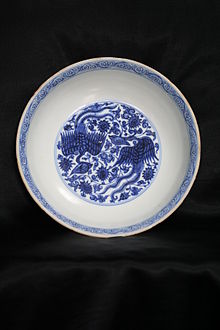Ming presentation porcelain
- Ming presentation porcelain
-

Front View, Nantoyōsō Collection, Japan
Ming presentation porcelain was a variety of high quality Chinese porcelain items included among the gifts exchanged in foreign relations during the Ming Dynasty. Among the great number and variety of Chinese ceramics found in Thailand and greater Southeast Asia is a variety that closely resembles Ming official ware in its use of dragon and phoenix motifs and high quality materials with workmanship. The scholar Liu Liangyou in an article entitled “Chinese Ceramics Excavated in Thailand” in the 49th issue of the National Palace Museum Monthly of Chinese Art, suggested that such finely executed ceramics could only be products of an official workshop and part of the gift system in place for Ming Dynasty foreign relations. Liang quotes the Ming Dynastic History (Mingshi) 339th chapter for Champa and Cambodia (Zhancheng Zhenla zhuan) for the year 1383. The Ming court presented Siam (Thailand) nineteen thousand items of ceramic ware. Three years later it is also noted that the court presented Cambodia with an unspecified quantity of ceramic items. We can assume that the number of items was significant also and the time period for such exchanged continued at least through the early Ming dynastic period. The blue-and-white phoenix dish reproduced here, and discovered in Southeast Asia, is identical to the example in the Boston Museum of Fine Arts, dated mid 15th century.
References
- Liu Liang-yu, “Chinese Ceramics Excavated in Thailand,” in National Palace Museum Monthly of Chinese Art, Taipei, 1987, pp. 81–86.
- Jan Fontein, Oriental Ceramics, vol. 10, Boston, 1980, plate 220.
Wikimedia Foundation.
2010.
Look at other dictionaries:
Chinese ceramics — Ming covered red jar with dragon and sea design from the Jiajing reign Chinese ceramic ware shows a continuous development since the pre dynastic periods, and is one of the most significant forms of Chinese art. China is richly endowed with the… … Wikipedia
arts, East Asian — Introduction music and visual and performing arts of China, Korea, and Japan. The literatures of these countries are covered in the articles Chinese literature, Korean literature, and Japanese literature. Some studies of East Asia… … Universalium
pottery — /pot euh ree/, n., pl. potteries. 1. ceramic ware, esp. earthenware and stoneware. 2. the art or business of a potter; ceramics. 3. a place where earthen pots or vessels are made. [1475 85; POTTER1 + Y3] * * * I One of the oldest and most… … Universalium
china — /chuy neuh/, n. 1. a translucent ceramic material, biscuit fired at a high temperature, its glaze fired at a low temperature. 2. any porcelain ware. 3. plates, cups, saucers, etc., collectively. 4. figurines made of porcelain or ceramic material … Universalium
performing arts — arts or skills that require public performance, as acting, singing, or dancing. [1945 50] * * * ▪ 2009 Introduction Music Classical. The last vestiges of the Cold War seemed to thaw for a moment on Feb. 26, 2008, when the unfamiliar strains … Universalium
China — /chuy neuh/, n. 1. People s Republic of, a country in E Asia. 1,221,591,778; 3,691,502 sq. mi. (9,560,990 sq. km). Cap.: Beijing. 2. Republic of. Also called Nationalist China. a republic consisting mainly of the island of Taiwan off the SE coast … Universalium
interior design — 1. the design and coordination of the decorative elements of the interior of a house, apartment, office, or other structural space, including color schemes, fittings, furnishings, and sometimes architectural features. 2. the art, business, or… … Universalium
lacquerwork — Any of a variety of decorative objects or surfaces, usually of wood, to which a coloured, highly polished, and opaque type of varnish called lacquer has been applied. True lacquerwork is Chinese or Japanese in origin. The technique was copied in… … Universalium
Topkapı Palace — Infobox Historic building name = Topkapı Palace caption = Topkapı Palace from the Bosphorus map type = latitude = longitude = location town = Istanbul location country = Turkey architect = Mehmed II, Alaüddin, Davud Ağa, Mimar Sinan, Sarkis… … Wikipedia
Confucianism — Confucianist, n., adj. /keuhn fyooh sheuh niz euhm/, n. the system of ethics, education, and statesmanship taught by Confucius and his disciples, stressing love for humanity, ancestor worship, reverence for parents, and harmony in thought and… … Universalium


